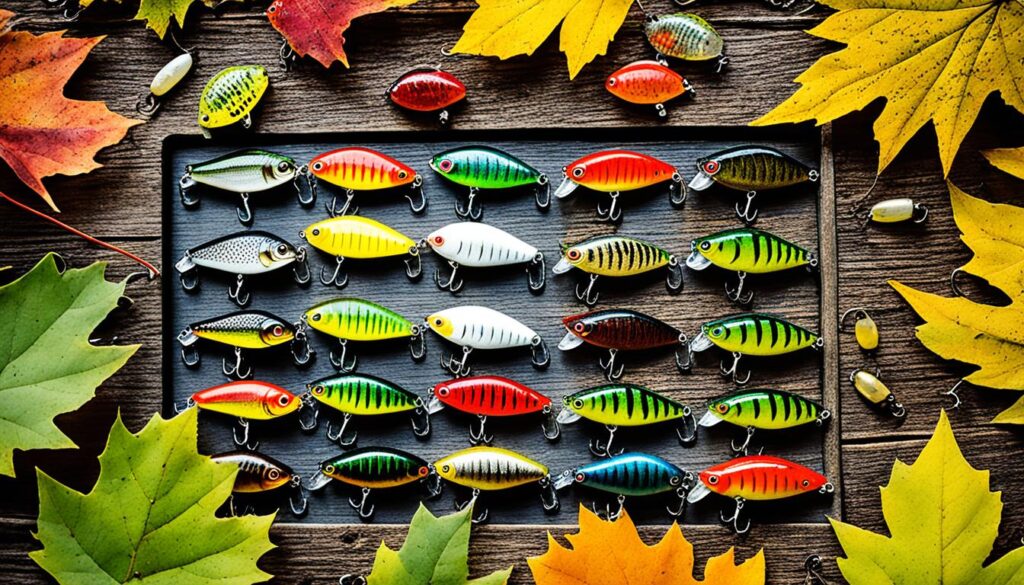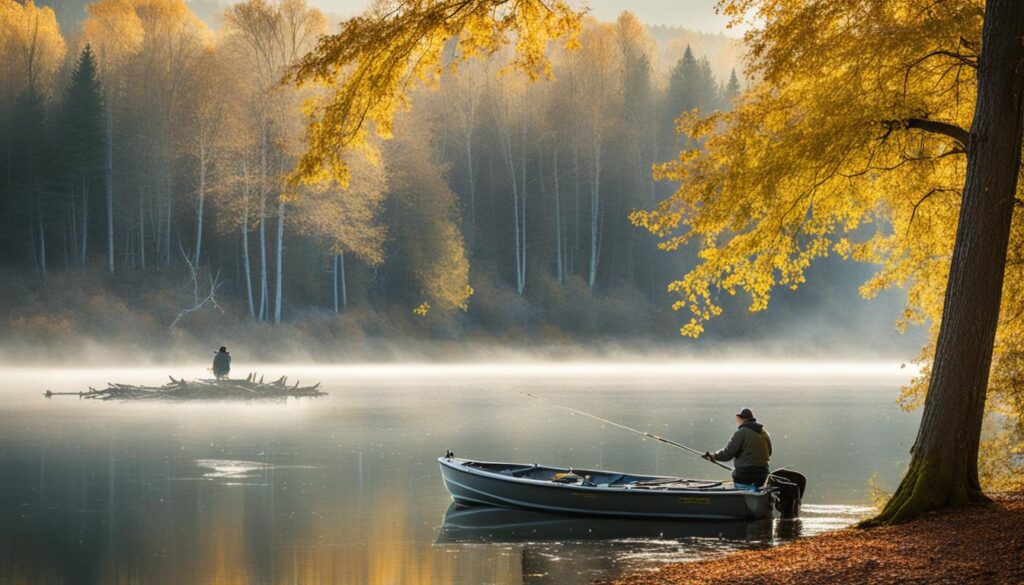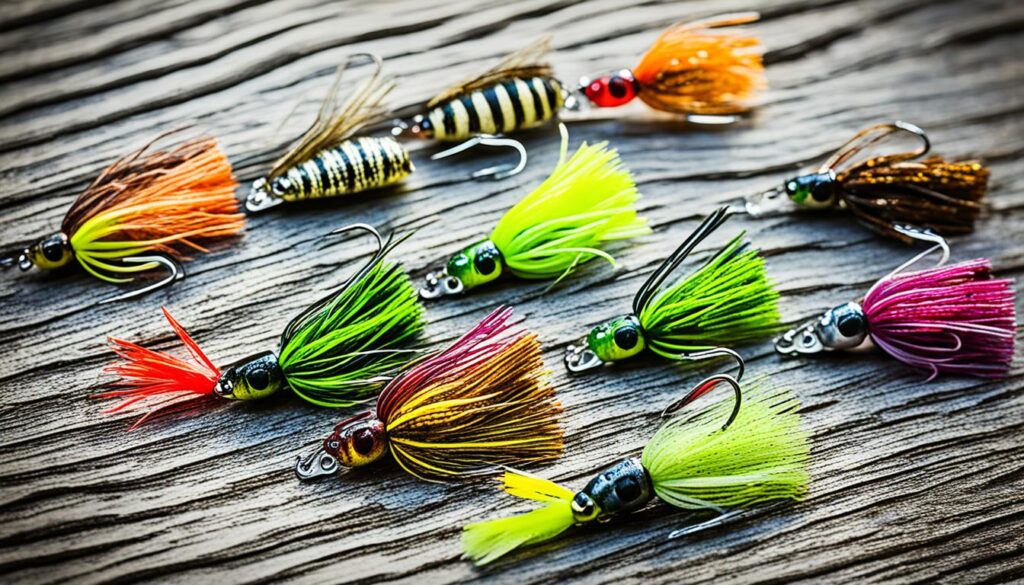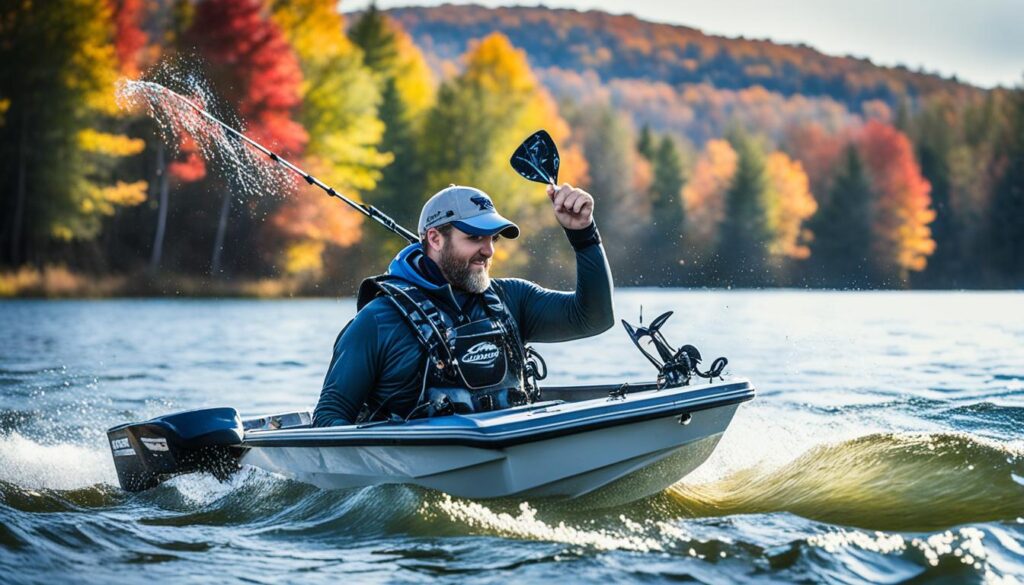Fall bass fishing can be challenging, but with the right flipping techniques, you can increase your chances of success. In this article, I will share 5 fall flipping tips that will help you catch more bass during the autumn season. These tips are based on the insights and experiences of professional anglers, and they focus on factors like current, forage, covering water, patterns in cover, and lure selection.
Key Takeaways:
- Consider current when flipping for bass in the fall.
- Match the forage to increase your chances of getting bites.
- Cover water and focus on shallow cover for more fall bass.
- Patterning different types of cover can help you locate more fish.
- Choose the right flipping bait based on the specific type of cover you are fishing.
The Importance of Current in Fall Bass Flipping
When it comes to fall bass flipping, understanding the importance of current is crucial for maximizing your success. The behavior of bass is heavily influenced by the presence or absence of current in their environment. This knowledge allows anglers to strategically target high percentage spots and increase their chances of finding actively feeding bass.
In river systems, where current is prevalent, fish tend to seek shelter in slack water areas close to the bank. These areas provide a break from the strong current and serve as prime locations for bass to ambush their prey. Some key spots to focus on in such conditions include current breaks, bluff walls, and channel swing banks. By targeting these high percentage areas, you can increase your chances of hooking into a trophy bass.
On the other hand, when there is little to no current, bass tend to spread out in search of baitfish. In these situations, it’s essential to cover more ground and explore different areas to locate active feeding bass. Keep in mind that areas with strong current are still worth considering, as they can serve as focal points for baitfish and bass activity.
To visually illustrate the importance of current in fall bass flipping, take a look at the table below:
| Current Strength | Fish Behavior | Recommended Strategy |
|---|---|---|
| Heavy | Seek shelter in slack water close to the bank | Target current breaks, bluff walls, and channel swing banks |
| Little to no | Spread out in search of baitfish | Explore different areas and cover more ground |
As you can see from the table, understanding the behavioral patterns of bass in relation to current can significantly impact your fall flipping success. By putting this knowledge into practice and adapting your strategy based on the current conditions, you’ll increase your chances of landing more bass.
Expert Insight: The Importance of Current
“Current is like a magnet for bass in the fall. It creates ideal feeding opportunities and positions fish in predictable spots. Understanding how current dictates fish behavior can be a game-changer in fall flipping.”
– Pro Angler, Brian Johnson
Matching the Forage to Catch More Bass
During the fall, bass are solely focused on feeding. To increase your chances of success, it’s crucial to locate areas with a high presence of baitfish. These baitfish can vary from shad to crawfish, so it’s important to match the resident baitfish in order to trigger strikes.
One way to determine the preferred forage is by paying attention to what the bass spit up when caught. This will give you valuable insights into what they are actively feeding on. By mimicking the resident baitfish, you can increase your chances of getting bites.
Rotate between different jigs and Texas rigs that resemble the resident baitfish. Varying your presentation will help you find the most effective one for the current conditions. Experiment with different colors, sizes, and patterns to find what works best.
It’s also important to note that baitfish tend to congregate in certain areas. By locating multiple areas with high baitfish activity, you can establish a pattern and increase your chances of finding a large congregation of bass.

Matching the Forage – Recommended Fall Bass Lures
| Lure Type | Features |
|---|---|
| Shad-imitating crankbaits | Realistic swimming action |
| Crawfish-imitating jigs | Life-like appearance |
| Swimbaits | Natural swimming motion |
| Spinnerbaits | Flash and vibration to attract attention |
| Soft plastic worms | Mimic various baitfish species |
Covering Water for More Fall Bass
In the fall season, bass undergo a transition phase that makes them constantly move in search of suitable feeding grounds. To maximize your chances of catching more bass during this time, it is essential to cover water effectively and efficiently. By flipping up shallow water cover and thoroughly exploring different areas, you can increase your opportunities for success.
When covering water, it’s important to dedicate ample time to fish each piece of cover properly. Make repetitive casts and experiment with changing your casting angle to explore the full potential of the area. This approach will not only help you to trigger reaction bites from nomadic bass but also enable you to identify the most productive spots within the cover. Remember, patience and persistence are key when it comes to covering water effectively.
While flipping, avoid skipping over potential hiding spots. Bass could be concealing themselves in unexpected areas, and by making multiple flips, you can thoroughly explore every part of the cover and increase your chances of locating active bass. Take your time and pay attention to detail, targeting all the nooks and crannies of the cover you encounter.
By implementing these bass fishing strategies for flipping and covering water, you can enhance your fall bass fishing experience. Thoroughly exploring each piece of cover, making repetitive and precise casts, and being attentive to potential hiding spots will help you maximize your chances of hooking into more bass. So be patient, persistent, and thorough in your approach, and you’ll increase your success rate on the water.
Patterning Cover for Fall Bass Flipping
When it comes to fall bass flipping, patterning different types of shallow water cover can be a game-changer. Fish tend to show a preference for specific types of cover throughout the day, meaning that if you get a bite in a particular spot, there’s a good chance you can find more fish in similar locations.
To establish a pattern, I recommend starting by fishing a mix of different banks at a quick pace. This will allow you to cover more ground and locate areas where the bass might be hiding. Once you start getting bites, slow down and thoroughly pick apart those areas. Pay close attention to the specific spots that produce the most action.
“By establishing a pattern, you can increase your chances of catching big limits of bass and having a successful fall bass flipping experience.”
Once you’ve found a productive pattern, it’s crucial to choose the right flipping bait for the specific type of cover you’re targeting. Different types of cover call for different lure presentations, so make sure to match your bait to the conditions at hand. This will maximize your chances of enticing those big bass to bite.
“Choosing the right flipping bait is essential for capitalizing on the pattern you’ve established and catching those elusive fall bass.”
Flipping Bait Recommendations for Different Types of Cover
| Cover Type | Recommended Flipping Bait |
|---|---|
| Vegetation and Lily Pads | Texas-rigged Senkos |
| Shallow Laydowns and Hard Cover | Beaver-style Plastics |
| Trees and Trash Mats | Flipping Jigs |
Remember, by patterning cover and selecting the right bait for each specific situation, you can significantly increase your chances of hooking into those trophy-sized fall bass. So get out there, experiment with different techniques, and enjoy a successful autumn bass fishing season!

Choosing the Right Flipping Bait for Fall Bass
The choice of flipping bait can greatly impact your success when targeting fall bass. As a professional angler, I recommend three main flipping baits that have proven to be effective: Texas-rigged Senkos, beaver-style plastics, and flipping jigs.
If you’re fishing around vegetation and lily pads, Texas-rigged Senkos are the way to go. Their soft, wiggly body imitates a variety of prey and entices bass to bite. The versatility of Senkos allows you to fish them in different ways, such as weightless or with a bullet weight, depending on the depth and cover you’re targeting.
When it comes to fishing shallow laydowns and hard cover, beaver-style plastics are my top recommendation. Their bulky bodies and flapping appendages create a lot of action in the water, grabbing the attention of nearby bass. With their natural profile and realistic movement, beaver-style plastics are hard for bass to resist.
For heavy cover like trees and trash mats, flipping jigs are your go-to bait. These jigs have a weed guard that helps prevent snagging, allowing you to fish in areas where bass love to hide. Pair your flipping jig with a soft plastic trailer, such as a craw or creature bait, to create a tempting presentation that bass can’t resist.
When selecting your flipping bait for fall bass, it’s important to vary your color selection based on the preferred forage in your fishing area. Pay attention to the natural colors of the baitfish or crawfish that bass are feeding on and choose flipping baits that closely mimic their appearance.
Pro Tip: Don’t be afraid to experiment with different colors and combinations to find what works best for the specific type of cover you are fishing.
Remember, each flipping bait has its own strengths and target areas. Having a well-rounded arsenal of flipping baits will give you the versatility and adaptability needed to catch more fall bass.
Recommended Flipping Baits for Fall Bass
| Flipping Bait | Target Cover | Recommended Colors |
|---|---|---|
| Texas-rigged Senkos | Vegetation, Lily Pads | Natural Green, Watermelon, Black/Blue |
| Beaver-style Plastics | Shallow Laydowns, Hard Cover | Green Pumpkin, Black/Blue, Watermelon Red |
| Flipping Jigs | Trees, Trash Mats | Black/Blue, Brown, Green Pumpkin |

Choosing the right flipping bait for fall bass is essential for a successful fishing outing. By matching the bait to the targeted cover and using colors that mimic the bass’ natural forage, you’ll increase your chances of hooking into more bass. So, gear up with these recommended flipping baits and get ready for some fall bass flipping action!
Fall Flipping as a Time-Tested Technique
Flipping throughout the fall has been a successful technique for many years and continues to produce results. It allows anglers to use their eyes and repeatable features to catch bass instead of relying solely on electronics. While fall fishing can be tough, mastering the art of flipping can help you catch big limits of bass when other techniques fail.
By understanding the importance of factors like current, forage, covering water, patterns in cover, and lure selection, you can elevate your fall bass flipping game and increase your chances of success.
“Flipping throughout the fall has been a successful technique for many years and continues to produce results.”
When it comes to fall bass fishing, flipping gives you the advantage of precision. You have the ability to target specific areas and present your bait exactly where the fish are hiding. By flipping heavy cover like trees, brush piles, and docks, you can entice bass to strike even when other techniques fail. The key is to approach each flip with accuracy, taking advantage of the bass’s natural reaction to ambush prey in cover.
One essential aspect of fall flipping is understanding the behavior of bass during this season. Bass tend to seek out areas of cover that provide both shelter and easy access to food. They can often be found close to submerged structures, along drop-offs, or near vegetation. By familiarizing yourself with their preferred habitats, you can effectively target potential feeding areas.
The Role of Forage in Fall Flipping
Forage plays a significant role in fall bass fishing, as bass are actively feeding to prepare for the approaching winter months. Paying attention to the types of forage present in your fishing location can help you select the right bait and increase your chances of success. Common fall forage includes shad, crawfish, and other small baitfish.
Awareness of the prevalent forage enables you to choose lures that mimic the natural prey of bass. Consider using flipping jigs alongside soft plastic trailers to imitate crawfish, which are a staple for many bass populations. The lifelike appearance and action of a well-presented flipping jig can trigger aggressive strikes from hungry bass in search of a hearty meal.
Table: Fall Flipping Bait Selection Recommendations
| Bait | Target Cover | Recommended Colors |
|---|---|---|
| Texas-rigged Senkos | Vegetation, lily pads | Green pumpkin, watermelon red flake |
| Beaver-style Plastics | Shallow laydowns, hard cover | Black/blue, green pumpkin |
| Flipping Jigs | Trees, trash mats | Brown, black/blue |
Remember to experiment with different colors to find what the bass are most responsive to in your local fishing spot.
In conclusion, fall flipping remains a time-tested technique that anglers can rely on to consistently catch bass. By leveraging your knowledge of bass behavior, selecting the right flipping bait, and honing your flipping skills, you can maximize your success during the autumn season.
Fall Flipping Conditions and Locations
Successful fall flipping relies on specific conditions that are conducive to catching bass. Understanding these conditions and adjusting your approach accordingly can greatly increase your chances of success. Here are some key factors to consider when planning your fall bass flipping strategy:
Bait Location: Baitfish play a vital role in fall bass fishing, as bass are actively feeding on them. The location of baitfish can vary from lake to lake and even change daily. Pay close attention to the movements of baitfish and let their presence guide you to areas where bass are likely to be feeding.
Weather Conditions: Ideal weather conditions for fall flipping include bluebird skies and calm winds. In these conditions, bass tend to position themselves tightly to cover, making it easier to target them. The absence of wind allows for more accurate and precise casts, increasing your chances of landing a successful flip.
Depth and Cover: During the fall, bass often move towards shallow water areas. When flipping, focus on targeting cover in 3 feet of water or less. Shallow cover such as grass mats, laydowns, docks, and brush piles are prime locations for fall bass flipping. By concentrating your efforts in these areas, you’ll be presenting your bait in the most productive zones where bass are likely to be hiding.
These ideal conditions and locations have proven to be fruitful for fall bass flipping. Understanding the importance of bait location, weather conditions, and targeting shallow cover will maximize your chances of catching more bass during the autumn season.
Optimal Bait Selection for Fall Flipping
In fall flipping, smaller, more subtle baits tend to outperform larger, bulkier baits. While big baits can catch big bass at other times of the year, fall bass are often more pressured and less likely to be fooled by larger offerings. To increase your chances of success, I recommend using the Missile Baits Missile Craw as your go-to bait for fall flipping.
The Missile Baits Missile Craw is a popular choice among anglers for fall flipping due to its small profile and darting action. This bait perfectly mimics a small crawfish trying to hide, making it an irresistible meal for bass. The lifelike action and appearance of the Missile Craw will entice even the most finicky fall bass.
When flipping smaller baits like the Missile Craw, it’s essential to use the right gear to optimize your performance. I recommend using a medium-heavy rod and a high-speed reel to handle the heavier cover and make accurate presentations. Fluorocarbon line is also ideal for fall flipping as it offers excellent sensitivity and low visibility underwater.
Cover Water and Think on Your Feet for Fall Flipping Success
Fall bass are constantly on the move, so covering water and thinking on your feet are key to fall flipping success. It’s important to adapt to changing conditions and move with the fish. By hitting as many similar areas as possible and thoroughly flipping each piece of shallow cover, you can increase your chances of catching more bass. Remember to keep your bait in the strike zone for as long as possible and make precise, pinpoint casts to likely bass hiding spots.
Conclusion
Fall bass flipping is a rewarding technique that can significantly enhance your autumn bass fishing experience. By carefully considering factors such as current, forage, covering water, patterns in cover, and lure selection, you can elevate your fall flipping game and increase your chances of success.
Adapting to changing conditions and focusing on shallow cover are key strategies to keep in mind. Additionally, choosing the right flipping bait for the specific type of cover you are fishing can make a significant difference in your catch rate. Be sure to cover water and thoroughly fish each piece of cover, as fall bass are constantly on the move.
With the right fall bass flipping tips and tactics, you can enjoy a fulfilling and successful bass fishing season during the autumn months. So grab your gear, head out to the water, and put these techniques into practice. Happy fishing!
FAQ
What are some fall flipping tips for catching more bass?
Fall flipping tips include considering factors like current, forage, covering water, patterns in cover, and lure selection. By understanding these factors, you can increase your chances of success when flipping for bass in the fall.
Why is current important when flipping for bass in the fall?
Current is important when flipping for bass in the fall because it influences fish behavior and positioning. Understanding how current affects fish can help you target high percentage spots and increase your chances of finding actively feeding bass.
How can I match the forage to catch more bass during fall flipping?
To match the forage and catch more bass during fall flipping, pay attention to what the fish spit up when caught. Rotate between different jigs and Texas rigs to mimic the resident baitfish and increase your chances of triggering strikes.
Why should I cover water when fall flipping for bass?
Covering water when fall flipping for bass allows you to catch more bass by making repetitive casts and changing your casting angle. This increases your chances of triggering reaction bites from nomadic bass and helps you locate the most productive areas.
How can I establish a pattern when fall flipping for bass?
To establish a pattern when fall flipping for bass, fish a mix of different banks at a quick pace and then slow down and pick apart the areas with the most bites. Once you find a productive pattern, choose the right flipping bait for that specific type of cover to maximize your chances of catching bass.
What are some recommended flipping baits for fall bass?
Recommended flipping baits for fall bass include Texas-rigged Senkos, beaver-style plastics, and flipping jigs. Texas-rigged Senkos work well around vegetation, while beaver-style plastics are ideal for shallow laydowns and hard cover. Flipping jigs are great for heavy cover like trees and trash mats.
Why is fall flipping a time-tested technique for catching bass?
Fall flipping is a time-tested technique for catching bass because it allows anglers to use their eyes and repeatable features to catch bass instead of relying solely on electronics. Mastering the art of flipping can help you catch big limits of bass when other techniques fail.
What are the optimal conditions and locations for fall flipping?
Optimal conditions for fall flipping include bluebird skies and calm winds, as bass tend to position tightly to cover in these conditions. As for locations, focus on shallow cover in 3 feet of water or less, as fall bass often move towards shallow water during this time.
What bait selection is optimal for fall flipping?
Smaller, more subtle baits tend to outperform larger, bulkier baits when fall flipping for bass. The Missile Baits Missile Craw, with its small profile and darting action, is a popular choice. When flipping smaller baits, use a medium-heavy rod, a high-speed reel, and fluorocarbon line for optimal performance.
How can I achieve fall flipping success by covering water and thinking on my feet?
Achieve fall flipping success by covering water and thinking on your feet by hitting as many similar areas as possible and thoroughly flipping each piece of shallow cover. Keep your bait in the strike zone for as long as possible and make precise, pinpoint casts to likely bass hiding spots.
